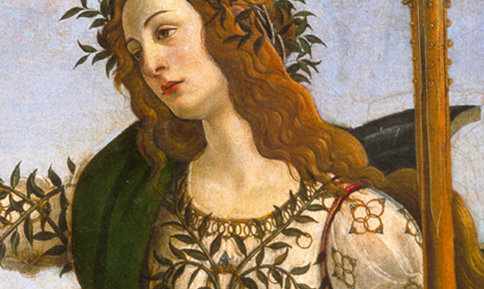Botticelli
dal 12/11/2009 al 27/2/2010
Segnalato da
12/11/2009
Botticelli
Stadel Museum, Frankfurt
With a selection of portraits, mythological allegories and depictions of the Virgin the Museum is presenting the first exhibition ever to be devoted to the oeuvre of this great Italian Renaissance master in German-speaking lands. The exhibition focuses on precious creations from all phases of Botticelli's oeuvre, confronts them with thematically related works by his colleagues, and examines them in the historical context of their making. Organized in three parts, it explores the painter's various tasks and thematic fields.

Curated by Andreas Schumacher
With a selection of portraits, mythological allegories and depictions of the Virgin – altogether some eighty works by Botticelli, his workshop and his contemporaries – the Städel Museum is presenting the first exhibition ever to be devoted to the oeuvre of this great Italian Renaissance master in German-speaking lands.
Sandro Botticelli’s painting has become a landmark of Italian Renaissance, and his monumental Idealized Portrait of a Lady (c. 1480) numbers among the Städel Museum’s main works. The ideal beauty of his mythological figures and the elegant grace of his Virgin figures make his creations the epitome of Florentine painting in the Golden Age under Lorenzo the Magnificent’s rule. It is less his masterful translation of Renaissance ideals which is the reason for the much-praised magic of his pictorial solutions, but rather the exceptional expressiveness of his figurative creations presenting their classically refined beauty in a solemn manner and with an often melancholy note.
Initially trained as a goldsmith and then apprenticed to Fra Filippo Lippi, Sandro Botticelli, next to Verrocchio, Ghirlandaio, and the Pollaiuolo brothers, ranks among the most successful painters in Florence in the second half of the quattrocento. From 1470 on, he received prestigious public commissions and made a name for himself as a painter of large altarpieces. Throughout his life, Botticelli was in the ruling Medici family’s and their supporters’ good graces. Fulfilling their wishes for innovative decorative paintings, the master could not only rely on his knowledge of Florentine traditions and of ancient art, but also on definite suggestions and concepts from the circle of humanists gathered around Lorenzo de’ Medici.
Held in equally high esteem as both a panel and a fresco painter, Botticelli enjoyed a high standing beyond his native Florence and was thus one of the artists summoned to decorate the walls of the Sistine Chapel in Rome by Pope Sixtus IV in 1481. It was particularly his much-discussed late work that brought out the characteristic features of his original style in an extreme manner. Guided by the art of drawing, Botticelli followed his penchant for rendering his figures with sharp contours, strong movements, and abundant gestures, grounding his compositions rather on textures of lines and surfaces than on spaces and volumes. In this respect, his painting had stood out against his competitors’ work and current theoretical demands since his early years. This is one of the reasons why art-historical research, which has devoted a vast number of major monographs and innumer-able work studies to Botticelli, still assigns a special position to the artist without fail even 500 years after his death on 17 May 1510.
All in all, it will be possible to show more than 80 works by Botticelli, his workshop, and some of his contemporaries like Filippino Lippi or Andrea del Verrocchio. The most important collections in Europe and the USA support the show with central works by the Florentine Renaissance artist. The exhibition focuses on precious creations from all phases of Botticelli’s oeuvre, confronts them with thematically related works by his colleagues, and examines them in the historical context of their making. Organized in three parts, it explores the painter’s various tasks and thematic fields. The portraits and allegorical paintings of the first section illustrate the degree of sophistication with which Botticelli drew on this highly developed genre and enriched it through new impulses. While the second chapter centers on his famous mythological representations of goddesses and heroines of virtue, the third part is dedicated to his abundant religious oeuvre.
Press Office, Städel Museum:
Dorothea Apovnik (department head), Kathrin Wiener, Marijke Gassen (assistant)
Städel Museum, Dürerstraße 2, 60596 Frankfurt, Telephone +49(0)69-605098-234, Fax +49(0)69-605098-188, presse@staedelmuseum.de
Opening 13 November 2009
Stadel Museum
Schaumainkai 63 - Frankfurt
Opening Hours: Tuesday, Friday to Sunday 10 am to 6 pm
Wednesday and Thursday 10 am to 9 pm, Monday closed
Gallery and exhibitions 7 Euros, reduced 5 Euros
Family ticket (two adults and at least one child) 15 Euros
Free admission: Children until 12
Members of the Städelscher Museums-Verein e.V. / Städelclub



